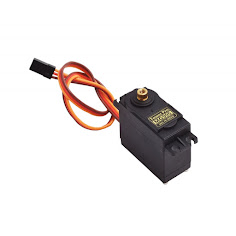Servo motor- Applications of Servo Motor -Servomechanism-Components of Servomechanism -Working of Servomechanism-Types of Servo System
Servo Motor
Servo motor is a device
that produces motion in response to a command, and then regulates the speed and
direction of that motion in response to feedback. The world of industrial
servos is a very diverse one.A servo motor is much more powerful than other
motors of the same size.Powerful magnets make servomotors exceptionally quick
and accurate. A feedback device called an encoder is built into the servomotor
at the back end.
Applications of Servo Motor
- Cameras
- Solar array
- Antenna positioning
- Robot pets
- Textiles
- Automatic doors
- Remote control toys
- Printing presses
Servomechanism
Servomechanism is an
automatic device for controlling large amounts of power by means of very small
amounts of power and automatically correcting the performance of a mechanism.
Components of Servomechanism
All servomechanisms have at least these basic components:
- Controller
- Command device
- Error detector
- Error-signal amplifier
- The Servomotor
Types of Servomechanism
- Hydraulic Servo System
- Pneumatic Servo System
- Electromechanical Servo System
- AC servo systems.
Working of Servomechanism
At the input to the servo amplifier is a controller. The controller provides the commands that dictate when and how the servomotor will move. The controller sends commands to the amplifier in the form of an analog signal or data. The controller and the amplifier also exchange position feedback from the encoder. The interface is used to start, stop and adjust the various functions of the machine. Interfaces can be simple buttons and indicator lamps or they may be a more complex human machine interface or HMI.
On the other end of the process the servo motor is connected to a mechanical system that it moves, but even if there's no connection. Turning on the servo isn't as simple as switching on a light bulb. It’s important to know that there are three stages to enable a servo. First, the amplifier itself must be turned on. We refer to this as Control Power. The system is typically wired to power up the controller and the operator interface at the same time Servo control power is established. The second stage is to apply the high voltage and high current power source that the amplifier will use to drive the motor. We refer to this as Main Power. The main power input allows flexibility and wiring to the servo amplifier.
The third stage is to energize the servomotor. We refer to this as Servo Enable. This signal to enable the motor comes from the controller. Servo enable doesn't mean the motor is moving, it only means that it's ready to move when commanded. Before the servo is enabled, the shaft will easily move but if you manually try to turn the shaft while the server was enabled, it will hold its position. You may hear a hissing sound as the servo works to maintain this position. After the servo motor is energized the controller typically requires the operator to press some type of a start button. At this point, the controller will command motion according to its program.
This particular controller is programmed to move the axis in both forward and reverse direction. To do so, it needs to define what forward and reverse means. What is considered forward for the servo may turn out to be reversed with respect to the machine. It is important to match the servo direction with the machine direction not only for programming the controller but also for any other features in the servo amplifier that are sensitive to direction






Comments
Post a Comment